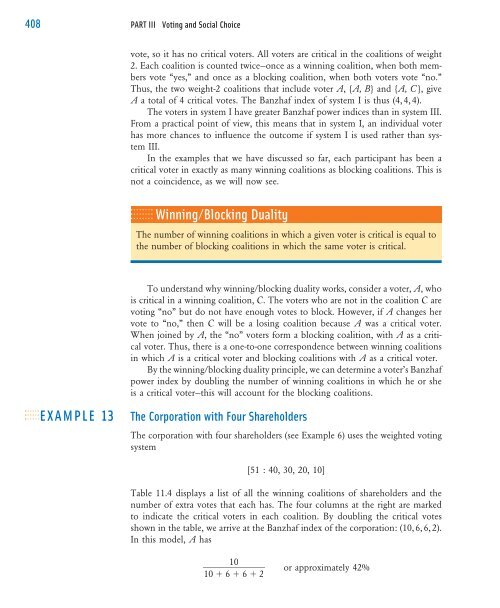Weighted Voting Systems - W.H. Freeman
Weighted Voting Systems - W.H. Freeman
Weighted Voting Systems - W.H. Freeman
- No tags were found...
You also want an ePaper? Increase the reach of your titles
YUMPU automatically turns print PDFs into web optimized ePapers that Google loves.
408 PART III <strong>Voting</strong> and Social Choicevote, so it has no critical voters. All voters are critical in the coalitions of weight2. Each coalition is counted twice—once as a winning coalition, when both membersvote “yes,” and once as a blocking coalition, when both voters vote “no.”Thus, the two weight-2 coalitions that include voter A, {A, B} and {A, C }, giveA a total of 4 critical votes. The Banzhaf index of system I is thus (4, 4, 4).The voters in system I have greater Banzhaf power indices than in system III.From a practical point of view, this means that in system I, an individual voterhas more chances to influence the outcome if system I is used rather than systemIII.In the examples that we have discussed so far, each participant has been acritical voter in exactly as many winning coalitions as blocking coalitions. This isnot a coincidence, as we will now see.Winning/Blocking DualityThe number of winning coalitions in which a given voter is critical is equal tothe number of blocking coalitions in which the same voter is critical.To understand why winning/blocking duality works, consider a voter, A, whois critical in a winning coalition, C. The voters who are not in the coalition C arevoting “no” but do not have enough votes to block. However, if A changes hervote to “no,” then C will be a losing coalition because A was a critical voter.When joined by A, the “no” voters form a blocking coalition, with A as a criticalvoter. Thus, there is a one-to-one correspondence between winning coalitionsin which A is a critical voter and blocking coalitions with A as a critical voter.By the winning/blocking duality principle, we can determine a voter’s Banzhafpower index by doubling the number of winning coalitions in which he or sheis a critical voter—this will account for the blocking coalitions.EXAMPLE 13The Corporation with Four ShareholdersThe corporation with four shareholders (see Example 6) uses the weighted votingsystem[51 : 40, 30, 20, 10]Table 11.4 displays a list of all the winning coalitions of shareholders and thenumber of extra votes that each has. The four columns at the right are markedto indicate the critical voters in each coalition. By doubling the critical votesshown in the table, we arrive at the Banzhaf index of the corporation: (10, 6, 6, 2).In this model, A has10 or approximately 42%10 6 6 2
















